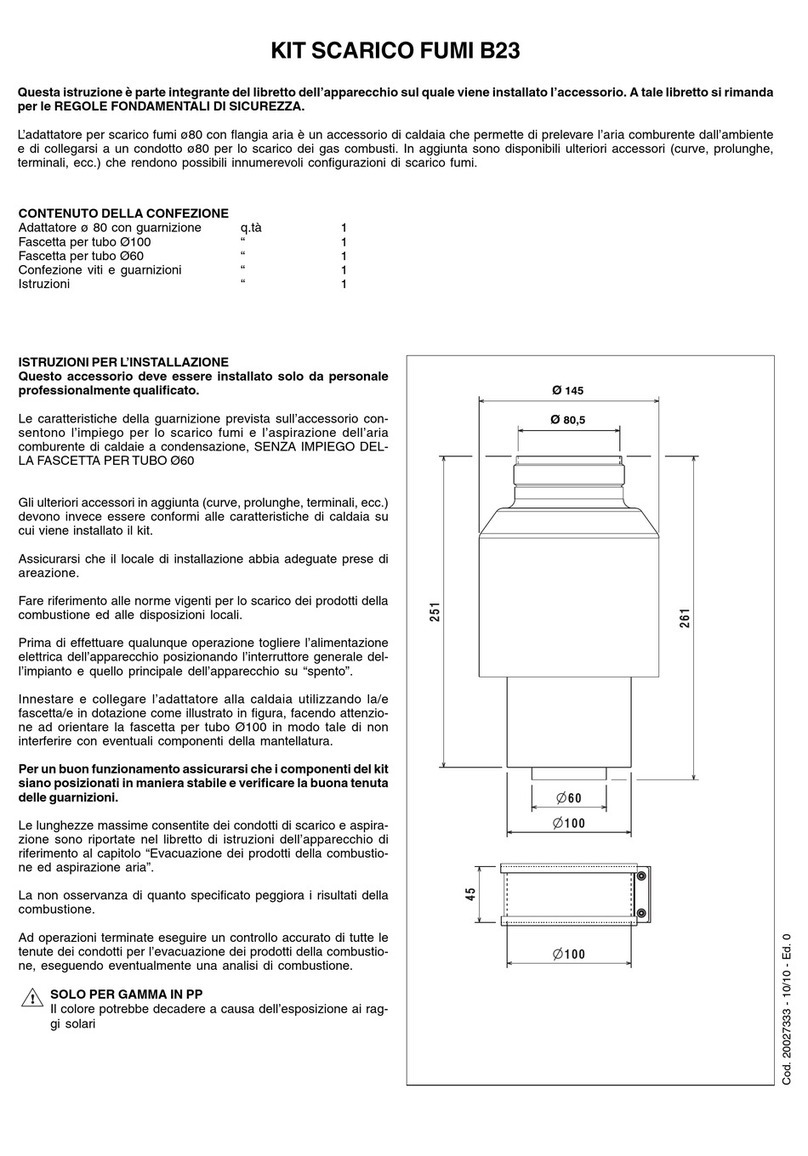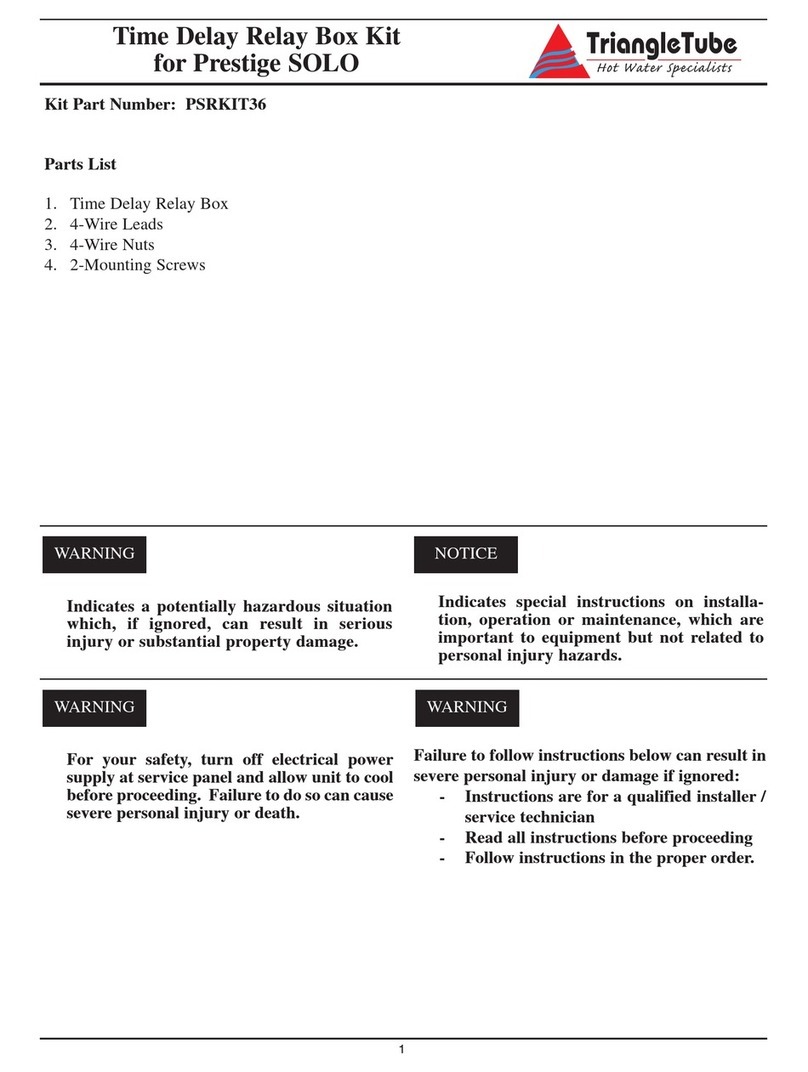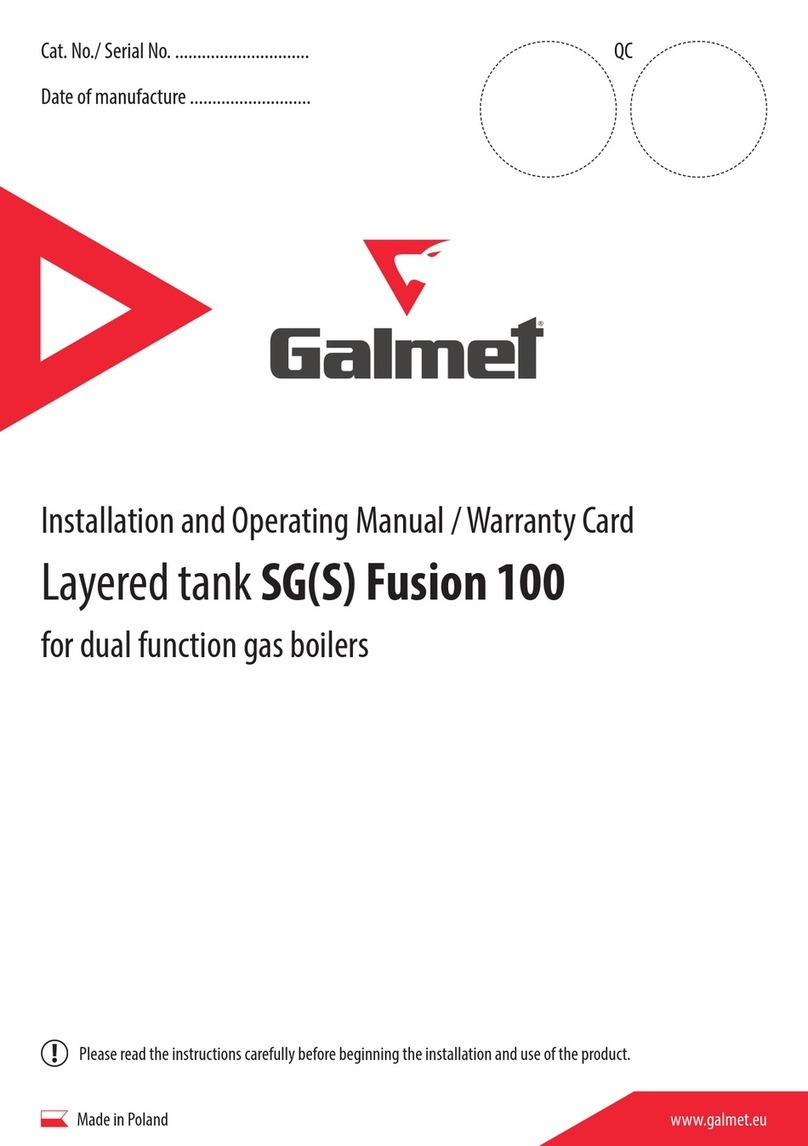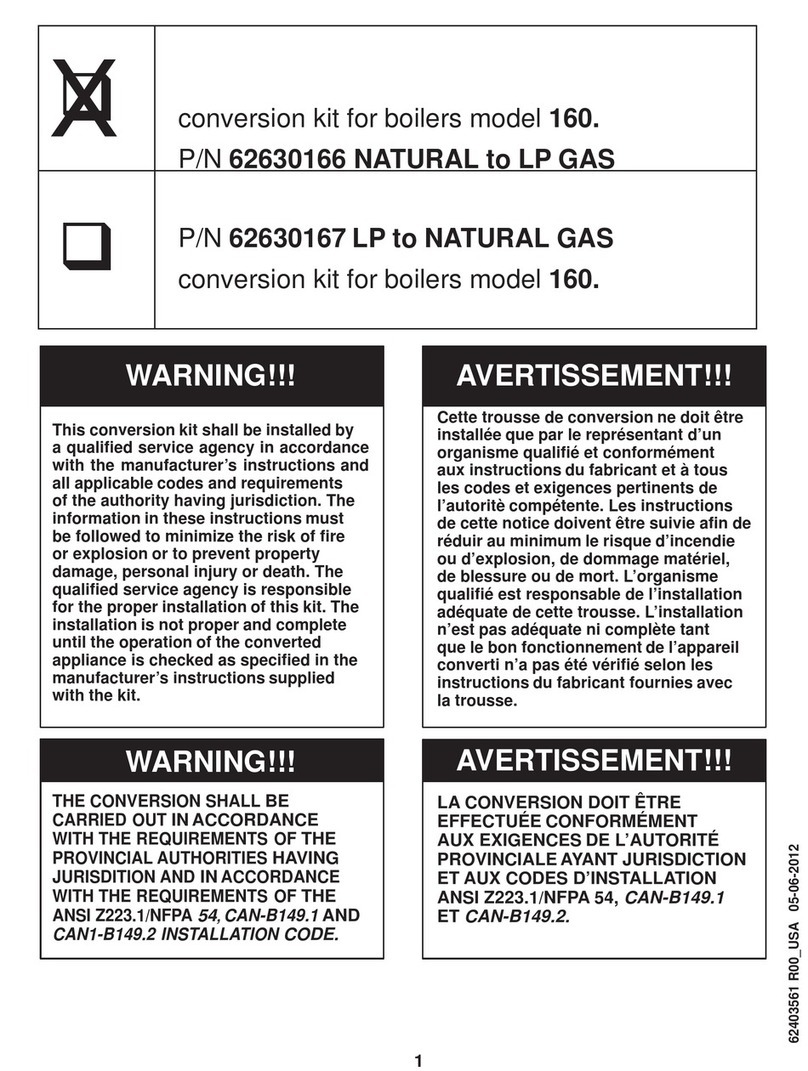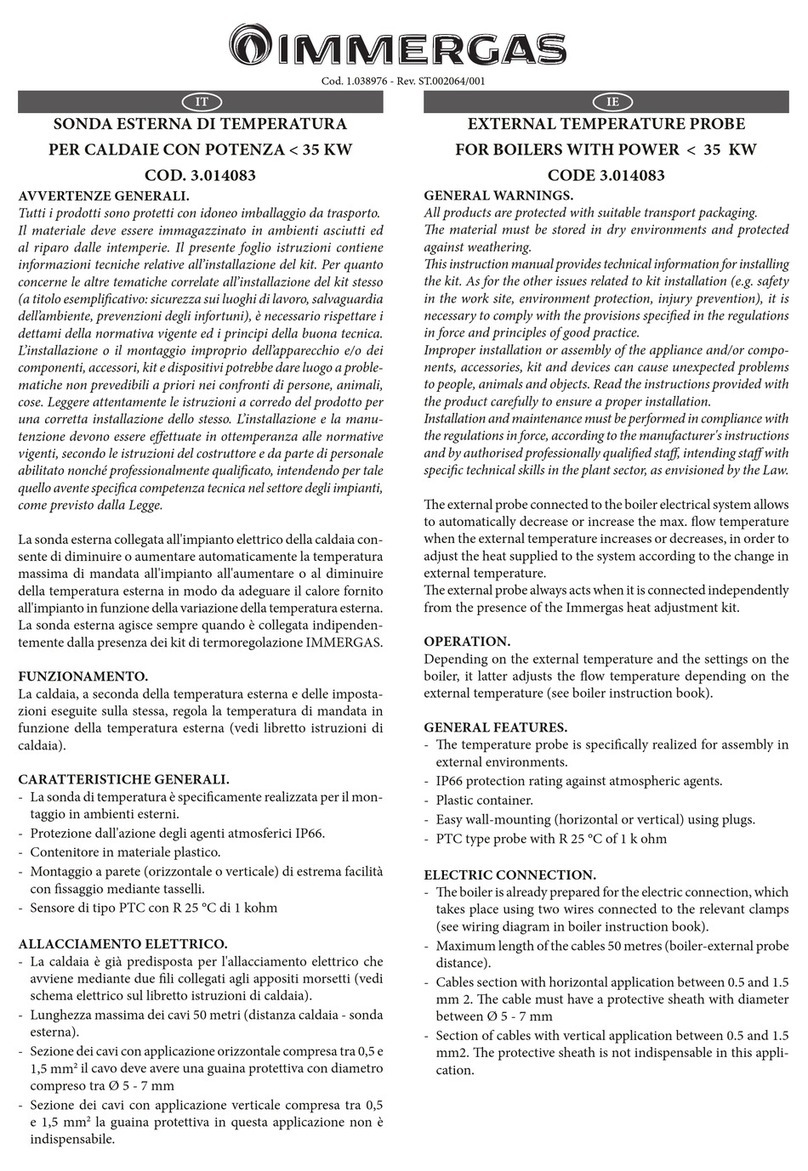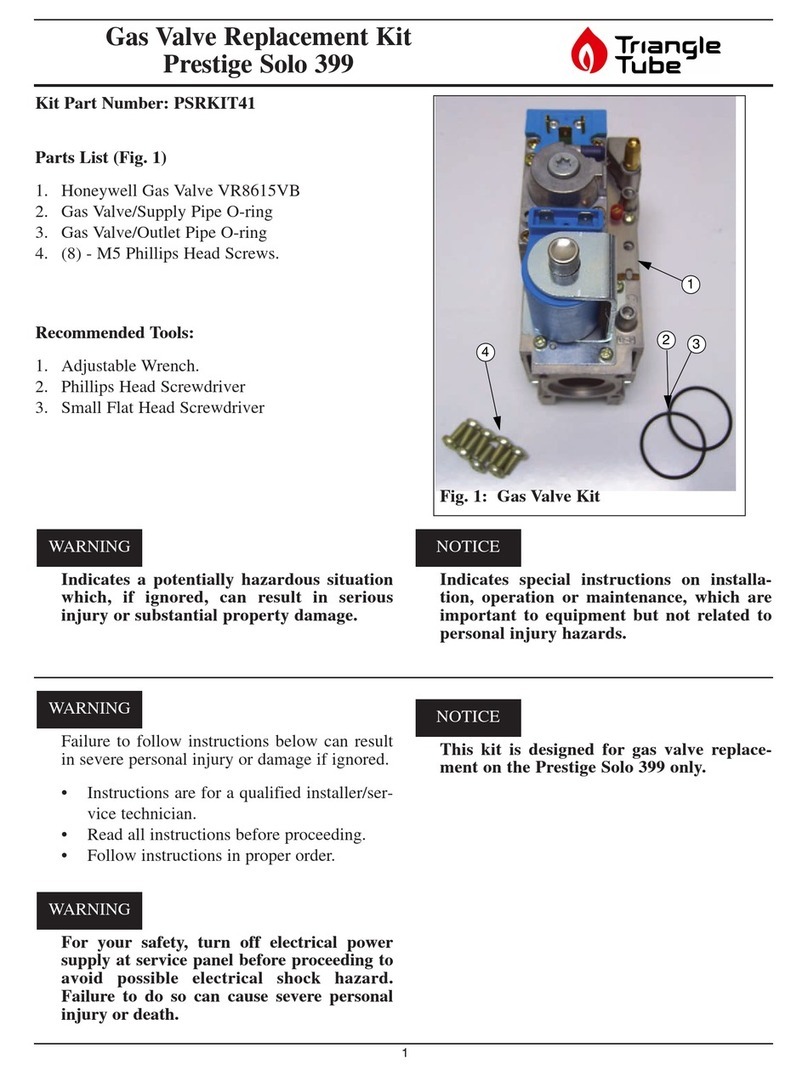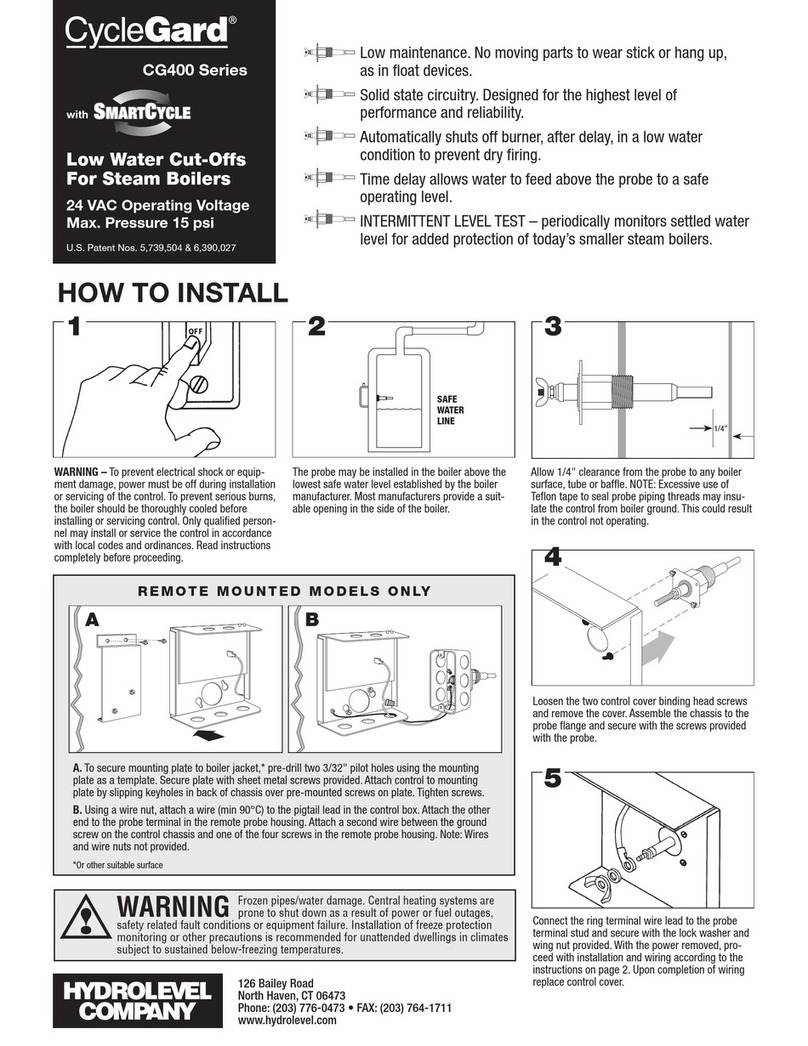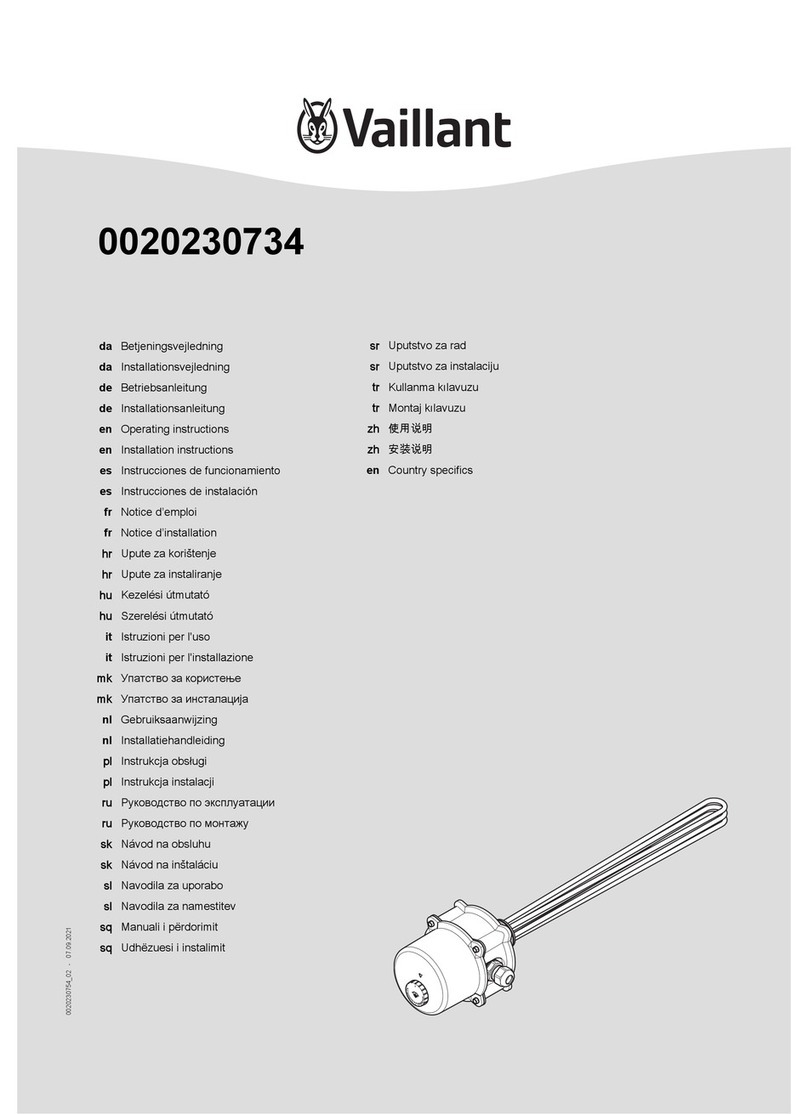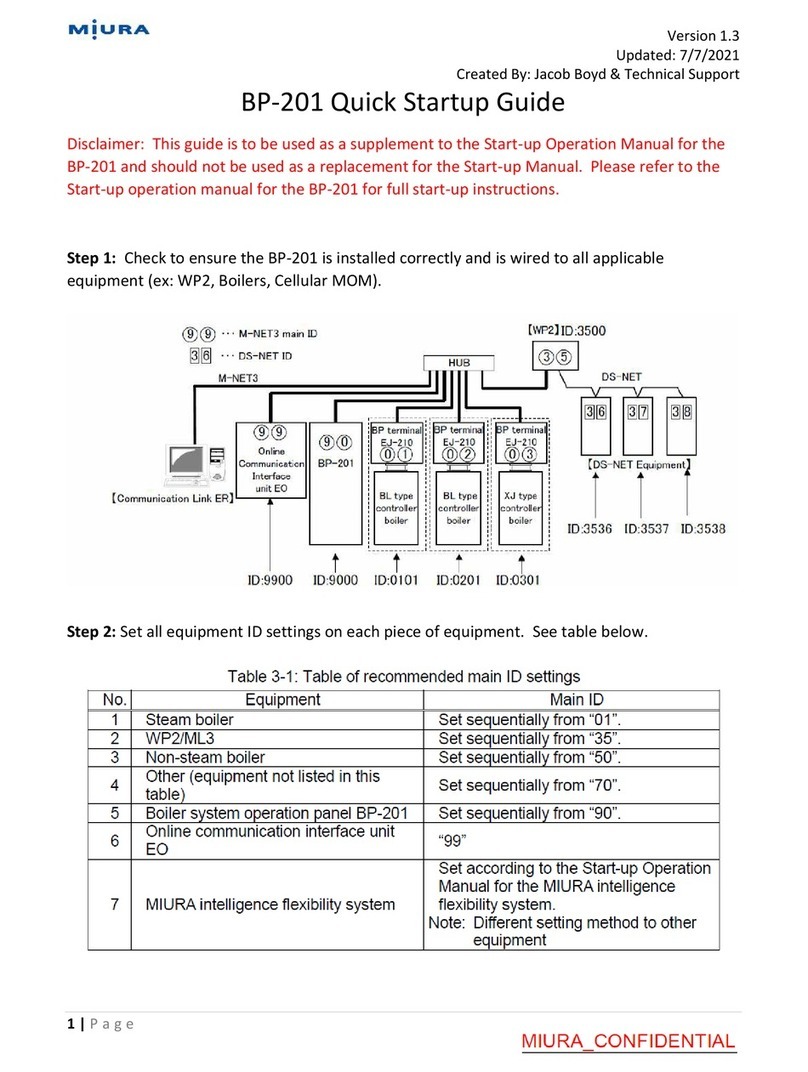Grant SpiraPod User manual

1
Grant SpiraPod Outdoor Enclosure
For Grant Spira Wood Pellet Boilers
Installation Instructions
Part No. DOC.46 Rev.04 19/05/17

2
EC Declaration of Conformity
In accordance with BS EN ISO/IEC 17050-1:2004
We Grant Engineering (IRL)
Of Crinkle
Birr
County Offaly
Ireland
Telephone: 057 912 0089
Fax: 057 912 1060
Email: info@grantengineering.ie
Website: www.grantengineering.ie
Declare that
Equipment: Floor Standing External Enclosure with integral Wood Pellet Hopper
Model Name/Number: Grant SpiraPod
In accordance with the following EC Directives:
2006/42/EC Conforms with the requirements of the Machinery Directive.
2006/95/EC Conforms with the safety objectives of the Low Voltage Directive and it’s
amending Directives
2004/108/EC Conforms with the essential protection requirements of the
Electromagnetic Compatibility Directive and it’s amending Directives
Has been designed and manufactured to the following Specifications:
EN60335-1:2012 Household and similar electrical appliances. Safety –General
requirements.
EN60335-2-102:2006+A1:2010 Household and similar electrical appliances. Safety. Particular
requirements for gas, oil and sold fuel burning appliances having
electrical connections.
EN55014-1:2006 Electromagnetic Compatibility. Requirements for household appliances.
EN303-5:2012 Heating Boilers for solid fuels. Manually or automatically stoked.
Nominal heat output up to 500kW.
MCS008 Product Certification scheme requirements - Biomass
Important Note for Installers
After installing the boiler leave these Installation Instructions with the appliance. Also leave both the
Installation and Servicing Instructions and the User Instructions (supplied with the boiler) with the
householder.
This appliance is deemed a controlled service and specific regional statutory requirements may be
applicable.

3
Contents
Section Page
1. Introduction 4
2. Technical Data 6
3. Installation 8
4. Pipework 13
5. Condensate Disposal 14
6. Sealed System Kit 15
7. Flue System 20
8. Electrical 24
9. SpiraVac System 26
10. Commissioning 27
11. Servicing 29
12. Spare Parts 30
13. Health & Safety Information 30
14. Guarantee 30
The following special text formats are used in this manual for the purposes listed below;
WARNING
Warning of possible human injury as a consequence of not following the instructions in the “warning”
CAUTION
Caution concerning likely damage to equipment or tools as a consequence of not following the
instructions in the “Caution”
NOTE
Used for emphasis or information not directly concerned with the surrounding text but of importance to
the reader.

4
1. Introduction
1.1 Grant SpiraPod Outdoor Enclosure
Figure 1-1: Front/right side view of Grant SpiraPod
1.2 Description
The Grant SpiraPod is a weatherproof housing for the external installation of the Standard Grant Spira
5/18, 6/26 or 9/36 wood pellet burning condensing boilers. It is constructed from 1.0mm, 1.5mm, and
2mm thick Galvanised steel, finished with a polyester powder coating in ‘Grant Grey’.
It is supplied fully assembled, with the pellet hopper and pellet auger fitted, ready for the installation of the
Grant Spira boiler. The integral pellet hopper has a capacity is 180 kg.
The Grant SpiraPod incorporates several doors and covers to allow easy access to the boiler for the
installation commissioning and servicing of the boiler contained within.
1.3 Pellet Hopper
The Grant SpiraPod pellet hopper has a capacity of approximately 180 kg. This is accessed by lifting the
hinged hopper lid on the top of the SpiraPod so that pellets can be tipped into the hopper by the user.
The hinged hopper lid is fitted with two gas struts to assist with opening and closing. This lid MUST BE
CLOSED after filling to prevent any water/rain entry
The hopper is fitted with a contents sensor. This detects when the level of pellets in the hopper falls to a
pre-set minimum level (approximately 20 kg) and, if a bulk pellet store is used, triggers the operation of
either a bulk store auger, or vacuum system, to deliver pellets from the bulk store. If no bulk store is used,
the contents sensor will stop the burner operating when the minimum pellet level is reached.
Topping up the hopper with more pellets will automatically operate the contents sensor and the burner
will restart (if there is a demand for the boiler to run). The hopper must be topped up with a further 10kg
(total of at least 30kg) of pellets to restart the boiler.
The electrical connection to the boiler is made to the 4-way electrical plug on the factory-fitted ‘flying lead’
from the Spirapod wiring centre, located at the front of the pellet hopper. Refer to both Section 8 of these
Installation Instructions and Section 8 of the Spira Installation & Servicing Instructions for electrical
connection details.

5
1.4 Flue System
The design of the Grant SpiraPod allows for the standard Grant Biomass flue system to be used. Refer to
Section 7 of these Installation Instructions and also Section 7 of the Installation & Servicing Instructions
supplied with the boiler.
1.5 Frost Protection
The Grant SpiraPod is supplied with a factory fitted frost protection thermostat. This is located inside the
SpiraPod enclosure on the rear of the SpiraPod wiring centre (located at the front of the pellet hopper).
Refer to Figure 1-2. It is pre-wired to the boiler SpiraPod electrical wiring centre and factory set to 2°C.
Grant recommends the use of a Pipe Thermostat (not supplied) in conjunction with the Frost thermostat
to avoid unnecessary and wasteful overheating of the property. This pipe thermostat should be located
on the boiler return pipe and set to operate at 25°C. Refer to the Section 8 of the Installation & Servicing
Instructions supplied with the boiler for details of the pipe thermostat electrical connections.
For total system protection against freezing, particularly during extended periods without electrical power,
Grant recommends the use of a combined heating system antifreeze and corrosion inhibitor, used in
accordance with the manufacturer's instructions.
1.6 Access
The SpiraPod enclosure is fitted with the following means of access:
A pair of hinged doors (with lockable door catch*) at the front –for access to the boiler for
routine cleaning (emptying the ash pan), access to boiler/burner controls and the Vacuum
system controls (if fitted).
A hinged hopper lid (with lockable door catch*) on the top left side –to allow pellets to be tipped
into the hopper by the user.
A hinged cover panel (with internal catch) on the top right side –to allow access to the top of the
boiler for Commissioning and Servicing.
A removable door panel (with lockable door catch*) at the rear –to allow access to the electrical
wiring centre and rear of boiler for commissioning and servicing.
* These door catches can be fitted with a small padlock (not supplied) if required.
To unlock and open any of the above, unlock/remove the padlock (if fitted). Rotate the knob of the catch
clockwise to unlatch and open the front door or pellet hopper lid. On the rear access door panel rotate
the knob anticlockwise to unlatch and remove. Close and lock the door, lid or panel using the reverse of
the above procedure.
Figure 1-2: Location of frost thermostat
Frost Thermostat
Wiring Centre

6
2. Technical Data
2.1 Technical Specification
Weight –excluding boiler (empty pellet hopper)
200 kg
Weight –excluding boiler (full pellet hopper)
380 kg
Weight –full pellet hopper and Spira 5-18 and 6-26 boiler (full)
663 kg
Weight –full pellet hopper and Spira 9-36 boiler (full)
702 kg
For further technical data refer to Section 2 of the Installation & Servicing Instructions supplied with the
Spira boiler.
2.2 Pump Specification (Sealed System Kits only)
Make and Model
Wilo Yonos PARA RS 15/7.0 RKC FS 130 12
Construction
Pump housing
Cast iron (with cataphorisis treatment)
Impeller
PP composite with GF 40%
Pump Shaft
Stainless Steel
Bearing
Carbon, metal impregnated
Protection Class
IPx4D
Insulation Class
F
Motor Protection
Integrated
Performance
Max Delivery Head
7.2m @ Q = 0 m3 /h
Max Volume Flow
3.3 0 m3 /h
Minimum Suction Head @ 50/95°C
0.5/4.5m
Power Consumption @ 1 –230V
3 –45W
Nominal Motor Power
37W
Current @ 1 –230V
0.028 –0.44 A
EEI
≤0.20
Speed
800 –4650 rpm
Settings
∆P-variable (1 –7m head) and Constant Speed (I, II and III)
Application
Maximum Static Pressure
PN6
Temperature Range @ Max Ambient
Temperatures
Max Ambient temperature 57°C: 0 to 95°C
Max Ambient temperature 59°C: 0 to 90°C
Max Ambient temperature 67°C: 0 to 70°C
Approved Fluids
Heating Water
Water/Glycol –Max 1:1 (above 20% check pumping data)
Energy Efficiency Index
The Grant Spira sealed system kits are supplied with a Wilo Yonos PARA circulating pump that complies
with the Energy Related Products (ErP) Directive requirement that all glandless circulating pumps have an
Energy Efficiency Index (EEI) of not more than 0.23 from the 1st August 2015.

7
2.3 Dimensions
Figure 2-1. SpiraPod overall dimensions

8
3. Installation Information
3.1 Regulations
The Installation of a Grant SpiraPod and Spira wood pellet boiler must be in accordance with the Building
Regulations and any local Byelaws, Water Regulations, British Standards and any other relevant
legislation. Refer to Section 4 of the boiler Installation & Servicing Instructions boiler for further details.
Refer to Local Building regulations for minimum distances between the SpiraPod and combustible
materials.
Check with the Local Authority regarding the possible need for Planning Permission for an external boiler.
3.2 Boiler location
The Grant SpiraPod can be installed either against the building or 'free standing' some distance away
from the building. Refer to Figures 7-4 and 7-5.
If the ‘free standing’ option is chosen, then the boiler flue system must be at least 2300mm away from
any buildings or structure that are higher than the flue outlet. See Figure 7-4. If this distance cannot be
achieved, then the SpiraPod will have to be located with the right hand side close to or against the
building and the flue system extended such that the terminal is above the eaves of the roof. Refer to
Figure 7-5.
The Grant SpiraPod must be positioned such that sufficient clearance is provided for maintenance,
servicing and filling the pellet hopper. In particular the following minimum clearances are required around
the SpiraPod:
Rear: 800mm (to remove panel and access to rear of boiler/hopper)
Front:1500mm (to open doors and install/commission/service boiler)
Pellet hopper side: 600mm (to access pellet hopper and open pellet hopper lid)
3.3 Base
The Grant SpiraPod must stand on a solid, level non-combustible surface capable of supporting both the
weight of the boiler when full of water, and the weight of the enclosure/pellet hopper when full of pellets.
Refer to Section 2 of these Installation Instructions for weights.
Grant recommends a prepared concrete standing (at least 150mm thick) with a smooth finish on the top
extending beyond the enclosure base at least 100mm all around.
3.4 Installation of SpiraPod
The Grant SpiraPod is supplied fully assembled, with the pellet hopper and pellet auger fitted, ready for
the installation of the Grant Spira boiler.
Position the SpiraPod in the required position/orientation on the concrete base and secure it to the
concrete, using suitable fixings (e.g. Rawlbolts or similar) through the two holes provided in the base at
the front of the enclosure. Refer to Figure 3-1.
Eight triangular steel shims are supplied with the boiler. These can be fitted under one or more corners,
as and when necessary, to level the SpiraPod (BEFORE securing it to the concrete base).

9
3.5 Installation of the Spira boiler
With both the front doors open and the rear access panel removed:
Remove the corner bracket from the top right hand corner of the front door opening. Refer to
Figure 3-2. Keep this bracket, and the four fixing screws, as this will need to be replaced once
the boiler is installed.
IMPORTANT
BEFORE fitting the boiler into the SpiraPod, It is essential that the pellet auger is rotated, as detailed
below, to ensure that the end of the auger outlet does not come into contact with the side of the boiler
during the installation process.
The auger is not fastened to the pellet hopper but is held in position by a bracket that fits over the
auger housing. Refer to Figure 3-3.
To rotate the auger; grasp the auger motor and auger outlet and carefully pull the auger out by
about 50mm until the auger mounting bracket is clear of the auger housing. Refer to Figure 3-4.
Figure 3-2. Top right corner bracket
Figure 3-3. Auger mounting bracket
Figure 3-1. Spirapod base
Rear stop rail
Guide rail
Fixing hole
Removable
section of
guide rail
Guide rail
Auger mounting
bracket
Corner bracket
Auger housing
Fixing hole

10
Rotate the auger clockwise until the auger outlet is facing directly downwards. Carefully allow the
auger to fall back into the auger housing until the bracket rests on the end of the auger housing
with the outlet still pointing directly downwards. Refer to Figure 3-5.
Remove the burner from the combustion chamber door of the boiler, taking care not to damage
the white gasket between the door and burner. Refer to Section 11.7 of the Installation &
Servicing Instructions supplied with the boiler for guidance on removing the burner.
Lightly lubricate the base area (using WD40 or similar lubricant). Do not use washing up liquid, or
anything similar, for this purpose as this may stain the base of the SpiraPod.
Position the boiler inside the SpiraPod, with the combustion chamber door facing forwards, and
align the sides with the two guide rails on the SpiraPod base. Refer to Figure 3-1
Carefully push the boiler towards the back of the SpiraPod enclosure until the rear edge of the
boiler base reaches the stop rail at the back.
NOTE: This process may be easier if a rope or similar (e.g. a lifting strop) is placed around the
base of the boiler and out of through the rear of the enclosure. The boiler can then be
simultaneously pulled and pushed into position against the rear stop rail.
Once in position it is not necessary to secure the boiler down to the base of the SpiraPod
enclosure.
Remove and discard the front section of the left hand guide rails, to allow the boiler combustion
chamber door to fully open. Unscrew and remove the rail fixing screws to remove this section of
guide rail only.
Fit the pellet feed tube to the burner so that the open end faces towards the left. Refer to Section
4.1.1 of the Installation & Service Instructions supplied with the boiler for details on the fitting of
the pellet feed tube.
Refit burner to the combustion chamber door and reconnect the two plugs from the boiler control
panel. Refer to Section 11.9 of the Installation & Service Instructions supplied with the boiler.
Fit the pellet feed tube thermostat lead onto the thermostat terminals. Refer to Section 10.5 of the
Installation & Service Instructions supplied with the boiler for details on the fitting of the pellet
feed tube thermostat lead.
Figure 3-4. Pull auger out from housing
Figure 3-5. Rotate auger clockwise

11
Connect the 6-way plug, on the flying lead from the pellet auger motor, to the upper socket on
the left side of the burner. Refer to Section 8 of the Installation & Service Instructions supplied
with the boiler for details of the plug connections.
Refit the corner bracket to the top right corner of the door opening using the four screws
previously removed.
Reposition the auger back in its original position in the auger housing. Ensure that the auger
mounting bracket is correctly fitting over the end of the auger housing. Refer to Figure 3-3.
Connect one end of the pellet delivery hose to the outlet of the pellet auger. Connect the other
end to the connector section of the pellet feed tube.
3.6 Fan Box and Flue Starter
With the boiler in the correct position, fit the fan box to the flanged flue outlet on the back of the boiler.
To do this, first fit the starter section to the fan box using the four screws provided (already fitted) in the
four sides of the fan box. Refer to Figure 3-6.
Figure 3-6. Flue starter section Figure 3-7. Fan box access panel.
Then, secure the fan box in place as follows:
Remove the nuts and washers from the four studs around the fan box inlet.
Remove the access panel from the rear face of the fan box. Refer to Figure 3-7.
Check the circular neoprene gasket in place on the fan box.
Feed the flue starter section up through the flue opening in rear top section of SpiraPod casing.
Locate the four studs through the corresponding holes in the gasket/fan box.
Two of the studs pass through the flange at the base of the fan box. The other two are inside the
fan box and are reached via the rear access opening.
Secure the fan box using the nuts and washers previously removed.

12
When tightening the nuts, ensure that the fan box and flue starter section is vertical and the
neoprene gasket is evenly compressed to give an adequate seal between the fan box and the
flanged boiler outlet.
Replace the access panel on the rear of the fan box and secure with the screws previously
removed.
Fit the 5-way plug from the flue fan/solenoid into the socket at the top right rear of the boiler.
Ensure that the plug is pushed fully home.
A Storm Collar (Grant Ref. WPB/SCIRL) is supplied with the SpiraPod. Carefully bend the collar until the
two outward facing flanges meet. Loosely fix the two flanges together using the two screws and nuts
supplied with the collar.
Fit the collar over the flue starter and position it in contact with the top surface of the SpiraPod enclosure.
Secure in position by tightening the screws. Finally, seal the storm collar to the flue/SpiraPod casing
using a suitable mastic sealant
Refer to Section 7 of these Installation Instructions and also Section 7 of the Spira Installation & Servicing
Instructions for full details on the flue system installation.
Fit the 5-way plug from the flue fan/solenoid valve into the socket at the top right rear of the boiler. Ensure
that the plug is fully pushed home. See Figure 4-1 in the Spira Installation & Servicing instructions.
Fit the solenoid head (fitted to the same 5-way plug as the lead from the flue fan motor) on to the valve
shaft of the wash system solenoid (located at the upper left rear of the boiler) and secure with the steel
clip provided.

13
4. Pipework
Refer to Section 4 of the Installation & Servicing Instructions supplied with the boiler.
4.1 General
Remove the rear door panel for access to the rear of the boiler to make all the pipe connections.
4.2 Flow and Return connections
The flow and return connections are located at the rear of the boiler. Refer to Section 2.4 of the Spira
Installation & Servicing Instructions supplied with the boiler for details.
The flow and return pipework can exit the SpiraPod enclosure either
a) Through the pre-cut openings provided in the ‘wall side’ (left side when viewed from the rear of
the SpiraPod –refer to Figure 2-1) and through the wall, when installed against the building, or
b) Down through the base at the rear of the SpiraPod, for ‘freestanding’ installations, using one or
both of the 150mm diameter pre-cut openings provided. Refer to Figure 4-1.
Push out the ‘knock-out’ from the required holes taking care not to distort the side casing panel or base
in the process.
If a Grant Sealed System kit is to be fitted, then refer to Section 6 of these Installation Instructions.
For condensate disposal pipework details, refer to Section 5 of these Installation Instructions.
4.3 Cold Water Connection (Wash System)
Connect a 15mm cold water supply pipe to the compression connection on the inlet to the double check
valve, located on the solenoid valve (mounted on a bracket on the rear of the boiler).
4.4 Condensate Connection
The1¼” BSP female condensate outlet connection is located at the rear of the boiler. Refer to Section 5 of
the Installation & Servicing Instructions supplied with the boiler for the location of this connection and
details on condensate disposal pipework.
4.5 Drain Cock
A connection is provided at the bottom rear of the boiler for the fitting of the ½” drain cock supplied with
the boiler. Refer to Section 4 of the Installation & Servicing Instructions supplied with the Boiler.
Do not fit the drain cock directly into this connection if using the Grant Sealed System kit, but refer to
Section 6 of these Installation Instructions for further details.
Figure 4-1. Location of pre-cut openings in SpiraPod base
Openings in base

14
5. Condensate Disposal
Refer to Section 5 of the Installation & Servicing Instructions supplied with the boiler.
5.1 General Requirements
When in condensing mode the Grant Spira condensing wood pellet boiler produces condensate from the
water vapour in the flue gases. This condensate is slightly acidic with a ph value of around 6.
Provision must be made for the safe and effective disposal of this condensate using one of the following
methods:
a) Into a soil stack –either directly or via an existing waste system.
b) Into an external gulley.
Refer to Section 5 of the Installation & Servicing Instructions supplied with the boiler for full details on the
requirements for a condensate discharge pipe.
NOTE
Due to the volume of wash-down water/condensate it is not recommended to discharge into a purpose
made soakaway.
5.2 Condensate Trap
All condensate disposal pipes must be fitted with a trap whether they are connected internally or
externally to a domestic waste system/soil stack or run externally to a gully or hopper.
Every Grant Spira boiler is supplied with a trap and this MUST be used. Refer to Section 5.6 of the boiler
Installation & Servicing Instructions for further details on the installation of the condensate trap.

15
6. Sealed System Kit (Optional)
Refer to Section 6 in the Installation & Servicing Instructions supplied with the boiler.
6.1 Sealed System Kit Contents
There are two sealed system kit for use with the Grant SpiraPod, depending on which boiler is being
used, as follows:
Item Description
Quantity
Spira
5/18 & 6/26
Spira
9/36
7m High efficiency circulating pump
1
1
22mm pump valves
2
n/a
28mm pump valves
n/a
2
Pump cable c/w moulded plug
1
1
1” Male Iron x 22mm compression connector
2
n/a
1¼” Male Iron x 1” reducer
n/a
2
1” Male Iron x 28mm compression connector
n/a
2
24 litre expansion vessel
1
1
Black Iron Tee
1
1
Expansion vessel hose
1
1
22mm pipe manifold c/w connections for AAV and PRV
1
n/a
28mm pipe manifold c/w connections for AAV and PRV
n/a
1
AAV
1
1
Tee assembly c/w pressure gauge
1
1
Filling loop kit
1
1
NOTE: The 2.5 bar PRV is supplied with the Grant Spira boiler, and not in the sealed system kits.
6.2 Fitting Sealed System Kit
To fit either of the two sealed system kits, follow the procedure below:
Fit the Black Iron tee into the ½” BSP socket (Drain Cock connection) at the bottom rear of the
boiler, using a suitable thread sealant. Position the elbow such that the centre connection of the
‘Tee’ points towards the right (when viewed from the rear of the SpiraPod).
Fit the ½ BSP male thread, on the end of the flexible expansion vessel hose, into the centre
connection of the ‘Tee’, using a suitable thread sealant.
Fit the drain cock (supplied with the boiler) into the open end of the ‘Tee’, using a suitable thread
sealant, such that the drain cock outlet faces downwards.
Check the expansion vessel change pressure. Refer to Refer to Section 6 of the Spira Installation
& Servicing Instructions supplied with the boiler for further details.
From the front of the SpiraPod, position the 24 litre expansion vessel under the pellet hopper with
the expansion vessel connection uppermost and facing towards the rear of the SpiraPod.
Working from the front of the SpiraPod, fit the ¾” BSP connection of the flexible expansion vessel
hose to the vessel using the black rubber washer supplied and tighten the nut.
Fit one of the 1” BSP MI x 22mm connectors (1¼” Male Iron reducer and 1”x 28mm connector for
the Spira 9/36) in the Flow connection at the rear of the boiler using a suitable thread sealant.

16
Fit the pressure relief valve (PRV) and automatic air vent (AAV) into their respective connections
on the manifold pipe using a suitable thread sealant. Position the PRV such that the outlet faces
to the left (when viewed from the back of the SpiraPod).
Fit the manifold pipe end into the compression section of the 1” BSP MI x 22mm connector
(28mm connector for the Spira 9/36). Refer to Figure 6-1.
Complete the flow pipe by fitting a 22mm compression or Tectite elbow (28mm on the Spira
9/36), to be supplied by Installer, on the open end of the manifold pipe.
Position the elbow such that the flow pipe passes either:
a) Directly through the side of the SpiraPod enclosure (using the semi cut opening provided), or
b) Downwards and out though a suitable lower opening in the SpiraPod enclosure
Fit the second of the 1” BSP MI x 22mm connectors (1¼” Male Iron reducer and 1”x 28mm
connector for the Spira 9/36) in the Return connection at the rear of the boiler using a suitable
thread sealant.
Fit the flow pipe into the compression section of the 1” BSP MI x 22mm connector (28mm
connector for the Spira 9/36). Refer to Figure 6-1. Use either a 22mm pipe (28mm on the Spira
9/36) with a swept bend, or two straight length of copper with either a 22mm compression or
Tectite elbow (28mm on the Spira 9/36).
Fit both 22 mm pump valves (28mm on the Spira 9/36) to the circulating pump using the sealing
washers supplied.
Fit the pump assembly in the return pipe ensuring that the pump shaft is horizontal and the pump
motor is facing away from the rear of the boiler. The flow arrow on the body of the pump must
face in the direction of flow i.e. towards the boiler return connection.
Fit a 15mm copper discharge pipe to the outlet of the pressure relief valve, using the nut and
olive supplied.
Route the PRV discharge pipe through one of the holes in the right hand side panel to discharge
in a safe but visible low level position above ground level.
The circulating pump should be wired into the heating system controls wiring centre. Refer to
Section 8 of the Installation & Servicing Instructions supplied with the boiler for details of the
wiring connections.
The pressure gauge and filling loop should be installed in a convenient position inside the
building.
6.2 Filling the Sealed System
Check the air charge pressure in the expansion vessel BEFORE filling the system
The Charge pressure must always be slightly greater than the maximum static head of the system. Refer
to Section 6 of the Spira Installation & Servicing Instructions.
Fill the heating system with water, as detailed in Section 6.2 of the Spira Installation & Servicing
Instructions. The system fill pressure (when cold) should exceed the vessel charge pressure by 0.2bar.
Check the operation of the Pressure Relief Valve, as detailed in Sections 6.4 respectively of the Spira
Installation & Servicing Instructions.

17
6.3 Connecting the Circulating Pump
The pump is supplied with a 3-core mains cable fitted with a moulded plug to provide a safe but easy
connection at the pump. First check that the plug is fully pushed onto the socket on the pump. Note that
the plug will only fit onto the pump socket one way.
Connect the pump cable to the heating system controls wiring centre. For connection details, refer to
Section 8 of the Installation & Servicing Instructions supplied with the boiler. Ensure that the three wires of
the pump cable are connected as follows:
Brown: Live
Blue: Neutral
Yellow/Green: Earth
WARNING
Before making any electrical connections to the hopper wiring centre, ensure that the electrical supply is
isolated at the fused spur serving the controls and boiler, and that the fuse has been removed and the
isolator is locked off.
Do NOT connect the electrical supply to the hopper, using the 4-way plug and socket, until ALL plug
connections have been correctly made between the hopper, boiler and (if fitted) the bulk pellet store.
Refer to Section 8.2 of these Installation Instructions for further details.
WARNING
Always check that the power to the boiler is isolated before disconnecting the plug from the pump.
Figure 6-1. Sealed system kit
6.4 Setting the Circulating Pump
Wilo Yonos PARA RKC circulating pumps have two possible setting modes:
Constant speed with three pump speed settings (I, II and III)
Variable pressure (∆p-v) with pump head adjustable between 1 and 7m head
Figure 6-2 shows the pump control panel with the red selector knob.
Constant Speed Mode (I, II, III)
This is the default setting of the pump and as such is recommended by Grant for heating systems. In this
mode the pump speed is not automatically regulated (as with the Variable Pressure Mode), but operates
constantly at one of the three possible speeds (set using the red selector knob on the pump control
panel).

18
Variable Pressure Mode (∆p-v)
In this mode the electronic control changes the differential pressure setpoint to be maintained by the
pump in a linear fashion between Hs (the value set using the red selector knob on the pump control
panel) and ½ Hs. The differential setpoint varies linearly with the volume flow Q.
Indicator LED
The pump is fitted with an indicator LED. This is located around the circumference of the red selector
knob. See Figure 6.2 below.This indicates the operating status of the pump and will be illuminated green
when the pump is operating normally. This indicator LED can assist in diagnosing and rectifying faults.
Refer to Section 6.5 of these Installation Instructions for further details.
Figure 6-2. Pump control panel with red selector knob and LED indicator
To set the pump to one of the two operating modes proceed as follows:
Constant Speed Mode (I, II, III)
Grant recommends this operating mode for the pump.
To set the pump to the ‘Constant Speed’ mode, the pointer on the red selector knob must be set to the
RIGHT of the mid position. See Figure 6.2 above.
Set it to point at the required speed setting, I, II or III as required, ensuring that there is adequate flow to
distribute the heat from the boiler whilst avoiding high water velocities causing noise in the pipework.
Variable Pressure Mode (∆p-v)
To set the pump to the ‘Variable Pressure’ mode the pointer on the red selector knob must be set to the
LEFT of the mid position. See Figure B above. The further anticlockwise it is set the greater the pressure
head setting of the pump –from 1m to 7m head.
If this mode is to be used, set the selector knob at a pressure that represents the maximum pressure
(head) loss for the heating system in question.
Constant Speed Mode
settings: I, II, III
Indicator LED
Variable Pressure Mode
settings: 1 to 7m head
Red selector knob

19
6.5 Circulating Pump Fault Diagnosis
The Indicator LED, located around the circumference of the red control knob, can assist in diagnosing
and rectifying a fault with the pump. See the table below.
LED condition
Meaning
Diagnostic
Cause
Remedy
Green
Pump operating
Pump runs
according to the
red knob setting
Normal operation
N/A
Flashes Red
and Green
Pump is operating
but stopped
Pump restarts by
itself after fault has
disappeared
Undervoltage
Voltage<160V
OR
Overvoltage
Voltage>253V
Check supply
voltage is
195V<V<253V
Overheating:
temperature inside
motor too high
Check water and
ambient temperature
Flashes Red
Pump not
operating
Pump stopped
(blocked)
Pump does not
restart itself due to a
permanent failure
Replace pump
LED off
No power supply
No voltage to
pump control
electronics
Pump is not
connected to power
supply
Check cable
connection
LED is damaged
Check if pump is
running
Electronics are
damaged
Replace pump
6.6 Recycling and Disposal of Circulating Pump
This circulating pump must not be disposed of in normal domestic waste as most of the materials used in
it’s construction can be recycled. For details on how to responsibly dispose of this pump please go to
www.wilo.com/recycling.

20
7. Flue System
Refer to Section 7 in the Installation & Servicing Instructions supplied with the boiler.
7.1 Air Supply
The Grant Spira boiler draws air for both combustion and the draught stabiliser from within the SpiraPod
enclosure. This has been designed to provide sufficient ventilation for this purpose, even when all covers
and doors are in place/closed. These ventilation openings are located along the lower edge of the front
hinged doors and along the top of the removable rear door. Refer to Figure 7-1.
No extra ventilation openings should be made in the SpiraPod enclosure.
IMPORTANT
The ventilation openings provided in the SpiraPod enclosure must be kept clear at all times for the boiler
to operate safely and correctly.
In winter conditions, a build-up of snow around the SpiraPod can obstruct the ventilation openings and
affect the operation of the boiler. Ensure that heavy snow is cleared away from around the SpiraPod as
soon as possible.
7.2 Flue Terminal Position and Clearances
The flue installation must be in accordance with the requirements of The Building Regulations Approved
Document J for appliances burning solid fuel.
Refer to Section 7.2 of the Installation and Servicing Instructions supplied with the boiler for details on the
correct location of flue terminals.
7.3 Boiler Flue Connection
The Grant Spira boiler is supplied with a flue fan box with a factory fitted starter section 300mm long.
Refer to Section 3.6 of these Installation Instructions for details on the fitting of the fan box and starter
section to the boiler.
7.4 Inspection Pipe
An Inspection pipe (Grant Ref. WPB/IPOM) is supplied with the Grant Spira boiler. This must be fitted to
the flue starter section. Refer to Section 7 of the Spira Installation and Servicing Instructions for details on
how to connect flue components together. The inspection pipe should be positioned such that the
circular cover plate faces towards the left side or rear of the SpiraPod/boiler.
This Inspection pipe incorporates a weatherproof cover under which is a flue inspection hatch and
combustion test point. Refer to Figures 7-2 and 7-3.
Figure 7-1. Location of air inlets in removable rear door
Ventilation
openings
Table of contents
Other Grant Boiler Supplies manuals

